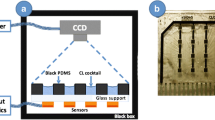Abstract
A biosensing platform based on surface plasmon resonance and incorporating a CMOS imager is being developed. This work comprises three different tasks towards this goal: a numerical analysis to determine the optimal plasmon resonance conditions, a numerical analysis to select the best CMOS photodiode and the architecture proposal of a CMOS imager. A simulation with COMSOL of a Kretschmann configuration using CMOS/post-CMOS compatible materials, a silicon dioxide prism and a gold–water interface, showed an optimal metal thickness of 50 nm and the associated incidence resonance angle of 68.46°. Then, a simulation with Silvaco ATLAS of two different CMOS photodiodes, a n-diff/p-sub and a n-well/p-sub, showed that the latter has a maximum quantum efficiency of 82 % and a photcurrent of 85 nA at 633 nm. This photodiode was selected as the photosensing element in a 20 × 20 μm2 pixel with a 61 % fill factor. A 32 × 32-pixel CMOS active column sensor (ACS) with fixed pattern noise (FPN) reduction was proposed. It includes non-correlated double sampling and double delta sampling schemes for noise handling. The reduction of the output’s variance was demonstrated through Monte Carlo analysis. An experimental optical setup was used to characterize the performance of the imager, obtaining a conversion gain of 7.3 μV/e− and a photodiode capacitance of 22 fF, showing good agreement with the values obtained with electrical simulation of 5.2 μV/e− and 31 fF. The measured full-well saturation was of 118.8 × 103 e− or 2.4 V. Finally, pixel-FPN and column-FPN of 0.09 and 0.06 % respectively were obtained. The low FPN levels demonstrate the benefits of the ACS and noise reduction circuits implemented. This work provide valuable information for the upcoming implementation of an integrated SPR-biosensing platform incorporating a CMOS-ACS.













Similar content being viewed by others
References
Ghafar-Zadeh, E., Sawan, M., & Therriault, D. (2007). Novel direct-write CMOS-based laboratory-on-chip: Design, assembly and experimental results. Sensors and Actuators A: Physical, 134(1), 27–36.
Yang-Lee, B., Min-Seo, S., Joon-Lee, D., Lee, M., Lee, J., & Cheon, J. H., et al. (2010). Biosensor system-on-a-chip including CMOS-based signal processing circuits and 64 carbon nanotube-based sensors for the detection of a neurotransmitter. Lab on a Chip, 10(7), 894–898.
Liedberg, B., Nylander, C., & Lundström, I. (1995). Biosensing with surface plasmon resonance how it all started. Biosensors and Bioelectronics, 10(8), i–ix.
Endo, T., Kerman, K., Nagatani, N., Morita, Y., Takamura, Y., & Tamiya, E. (2005). Localized surface plasmon resonance based label-free optical biosensor for monitoring peptide nucleic acid–DNA hybridization. 5th IEEE Conference on Nanotechnology, 332–335.
Krishnamoorthy, G., Carlen, E. T., Bomer, J. G., Wijnperlé, D.,deBoer, H. L, & van den Berg, A., et al. (2010). Electrokinetic label-free screening chip: A marriage of multiplexing and high throughput analysis using surface plasmon resonance imaging. Lab on a Chip, 10(8), 986–990.
Chyan, J. Y., & Yeh, J. A. (2006). CMOS-compatible biological surface plasmon resonance nanosensor. IEEE/LEOS International Conference on optical MEMS and Their Applications, 76–77.
Rhee, J., Wang, D., Tao, N. J., & Joo, Y. (2004). CMOS image sensor array for surface plasmon resonance spectroscopy. International Society for Optics and Photonics, Electronic Imaging 2004, 34–41.
Homola, J. (2006). Surface plasmon resonance based sensors. Springer, Berlin.
Salazar, A., Camacho-León, S., Rossetto, O., & Martínez-Chapa, S. O. (2013). Electromagnetic modeling of surface plasmon resonance with Kretschmann configuration for biosensing applications in a CMOS-compatible interface. Proceedings of SPIE 8619, 86190V.
AMS. (2008). 0.35 μm CMOS C35 process parameters. Austriamicrosystems, Eng-182, Rev. 6.0.
ATLAS Users Manual. (2010). Device simulation software. SILVACO International, Santa Clara, CA.
Simpson, M. L., Ericson, M. N., Jellison Jr., G. E., Dress, W. B., Wintenberg, A. L., & Bobrek, M. (1999). Application specific spectral response with CMOS compatible photodiodes. IEEE Transactions on Electron Devices, 46(5), 905–913.
Sze, S. M., & Ng, K. K. (2006). Physics of semiconductor devices. Wiley, Hoboken, NJ.
Darmont, A. (2009). Spectral response of silicon image sensors. White Paper, 4.
Nakamura, J. (2006). Image sensors and signal processing for digital still cameras. CRC Press, Boca Raton, FL.
Vogelsong, T. L., Zarnowski, J. J., Pace, M. A., & Zarnowski, T. L. (2000). Scientific/industrial camera-on-a-chip using active column sensor CMOS imager core. International Society for Optics and Photonics, Electronic Imaging. 102–113.
Goy, J. (1992). Etude, conception, et réalisation d’un capteur d’image APS en technologie standard CMOS pour des applications faible flux de type viseur d’étoiles. Ph.D. Thesis Institut National Polytechnique de Grenoble.
Nixon, R. H., Kemeny, S. E., Pain, B., Staller, C. O., & Fossum, E. R. (1996). 256 × 256 CMOS active pixel sensor camera-on-a-chip. IEEE Journal of Solid-State Circuits, 31(12), 2046–2050.
Beecken, B. P., & Fossum, E. R. (1996). Determination of the conversion gain and the accuracy of its measurement for detector elements and arrays. Applied optics, 35(12), 3471–3477.
El Gamal, A., Fowler, B. A., Min, H., & Liu, X. (1998). Modeling and estimation of FPN components in CMOS image sensors. Proceedings in SPIE. 3301, 168–177.
Chen, T., Catrysse, P. B., El Gamal, A., & Wandell, B. A. (2000). How small should pixel size be?. Proceedings in SPIE, 3965, 451–459.
Author information
Authors and Affiliations
Corresponding author
Rights and permissions
About this article
Cite this article
Salazar, A., Camacho-Leon, S., Martínez-Chapa, S.O. et al. Towards a SPR-based biosensing platform incorporating a CMOS active column sensor. Analog Integr Circ Sig Process 77, 365–372 (2013). https://doi.org/10.1007/s10470-013-0190-z
Received:
Revised:
Accepted:
Published:
Issue Date:
DOI: https://doi.org/10.1007/s10470-013-0190-z




